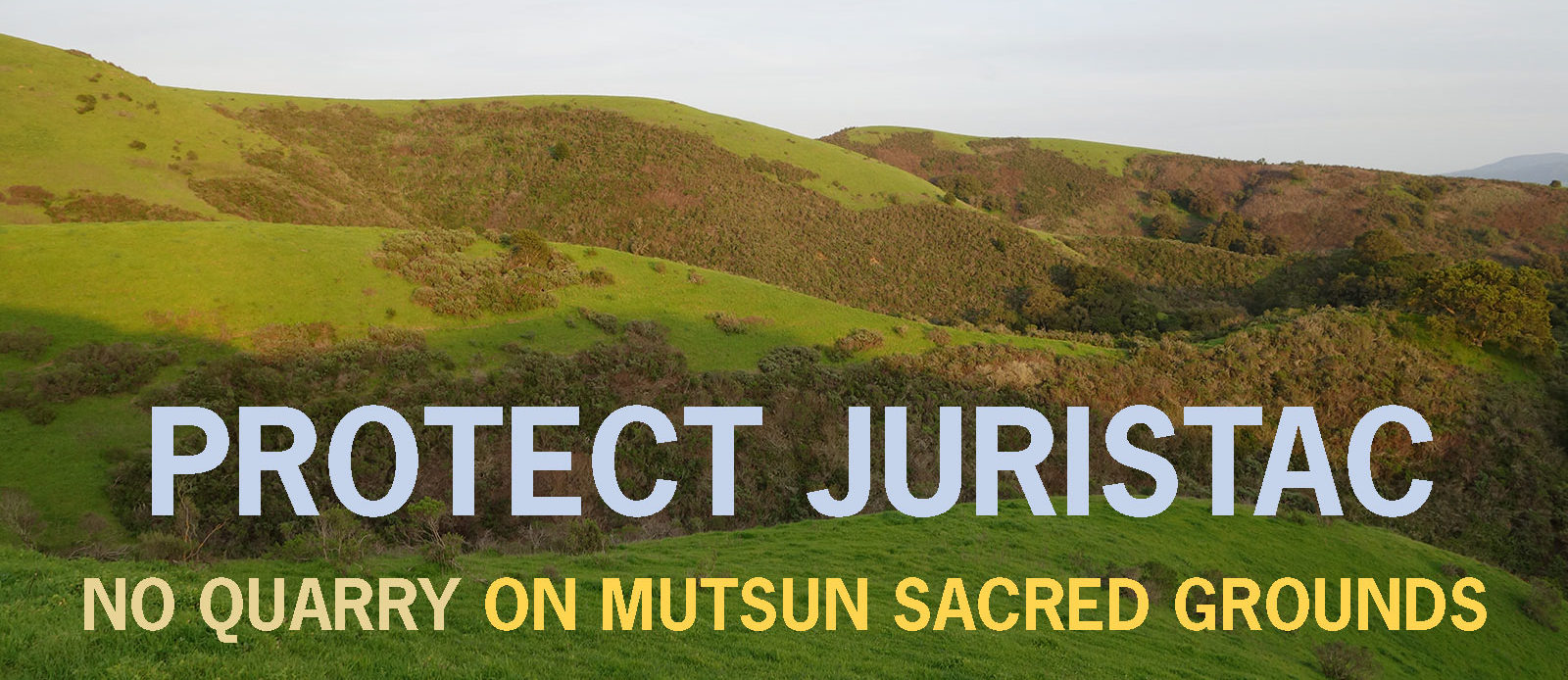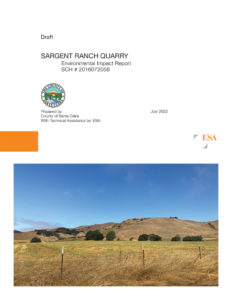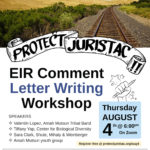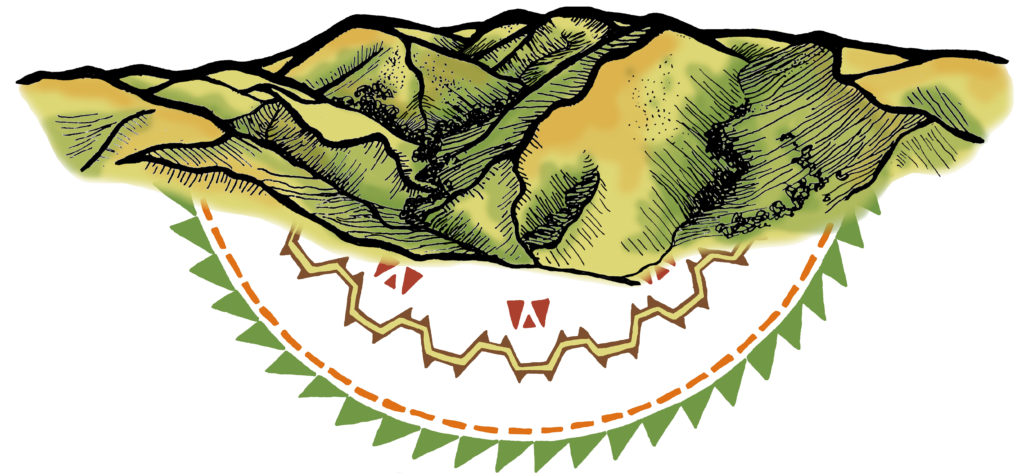
Winter 2022 Update: The official comment period on the Draft Environmental Impact Report for the proposed Sargent Quarry project that threatens Juristac has now closed, however, you can still submit a letter with your comments and concerns to the Santa Clara County Planning Commission and Board of Supervisors.
Although the County is not legally obligated to incorporate late comments in their revisions to the Draft EIR, they may still choose to do so at their discretion. In any case, your message will reach the decision makers who will be voting to approve or deny the mining permit. The Planning Commission will make an initial decision, which is then sure to be appealed to the Board of Supervisors for a final decision. (See contact information under “How to submit your comment letter.”
Your voice is needed: A public comment period for the proposed mining project that threatens Juristac is now open, following the publication of the Sargent Quarry Draft Environmental Impact Report (DEIR) by Santa Clara County. The planned 403-acre mining operation and processing plant would devastate the most sacred site of the Amah Mutsun Tribal Band, eliminate precious grassland and oak woodland habitat, and disrupt a critical wildlife movement corridor.
The Amah Mutsun Tribal Band vehemently opposes this planned mining operation on our sacred grounds at Juristac and we are asking for your support. Our collective success in defeating this project depends on overwhelming, vocal and unified public opposition. This public comment period ending on September 26 November 7th is a crucial opportunity to challenge this destructive project and submit your specific concerns to Santa Clara County. We are counting on you to take action.
jump to section
- What is an EIR and why write a comment letter?
- Download the Draft Environmental Impact Report
- How to submit your comment letter
- Further action steps you can take during the comment period
- General tips for writing effective comment letters
- Key areas of concern in the Sargent Quarry DEIR (NEW)
- Basic comment letter template
- Additional resources to support comment drafting
- Juristac EIR Comment Writing Workshop Video
- Virtual Planning Commission Hearing: August 25
- Frequently Asked Questions
What is an EIR and why write a comment letter?
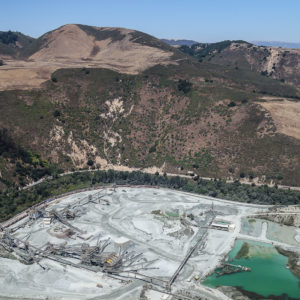
In response to a mining permit application submitted by the San Diego-based Debt Acquisition Company of America (doing business as Sargent Ranch Partners LLC), the County of Santa Clara prepared an Environmental Impact Report to assess the detrimental effects the proposed mining project would have on the environment, covering 14 primary topics such as biological resources, air quality, transportation and cultural resources. The findings of this report will guide the decision made by the Santa Clara County Planning Commission—and ultimately the Board of Supervisors if the initial decision is appealed—as to whether to approve or deny the mining permit.
The 650-page draft Environmental Impact Report is provided to the public for review and comment within a limited 60-day period. Anyone can submit comments in the form of letters, as well as short spoken remarks delivered at the Planning Commission’s public hearing on August 25th. The County is legally obligated by the California Environmental Quality Act (CEQA) to review and respond to the comments received, and to amend the EIR in response to substantive new information provided within public comments.
Comment letters are a powerful tool to convey the viewpoints of the public to decision makers and to challenge the adequacy of analysis and findings contained within an EIR. The more detailed, specific, and well referenced your comment letter is, the more effective it will be. However, don’t be intimidated—even a simple letter expressing your concerns regarding the proposed mining project and the contents of the EIR is a valuable contribution.
Our large influx of comment letters will send a clear message to Santa Clara County decision makers that the public is watching the issue closely and is extremely concerned with the destructive cultural and environmental impacts of the proposed project. This showing of broad community support is of critical importance to our collective efforts to ensure that the mining permit is ultimately denied.
Download the Draft Environmental Impact Report
You can access the Draft Environmental Impact Report (DEIR) here on the County of Santa Clara’s webpage. Click on the first link titled “Draft Environmental Impact Report” to download the 650-page PDF. Although the document is extremely long, it is well organized into sections so you can review only the parts of most interest to you. We recommend that you take notes as you read, to later reference in drafting a comment letter should you choose to do so.
The 650-page Draft EIR is accompanied by a series of appendices, technical reports, site maps, plans and specifications which are also important to review and consider commenting on. All of these supplemental sections of the EIR are contained within the County of Santa Clara’s webpage for the project.
How to submit your comment letter
You can submit your comments in the text of an email, or in an email attachment containing a PDF or Word document with a cover message indicating that your comment letter is attached.* Ensure that your comment letter includes your full name and address and states the name of the project (“Sargent Ranch Quarry Project”) at the top. All comments must be submitted to the designated county email address to be added to the official record. Address your comments to:
Robert Salisbury, Senior Planner
Santa Clara County Department of Planning & Development
sgtquarry.comments@pln.sccgov.org
Please make sure to CC or BCC your email to our campaign team so that we can also track and keep a record of the comments submitted:
BCC all comment emails to:
eircomments@protectjuristac.orgIn addition, consider adding a CC to the Planning Commission at:
planning.commission@pln.sccgov.org
And/or the Santa Clara County Board of Supervisors at:
boardoperations@cob.sccgov.org
* If you make reference to any documents in your EIR comments, be sure to attach full copies as part of your EIR comments. Don’t assume the planning department has access to any document, report or resource that you are referencing.
Further action steps you can take during the comment period
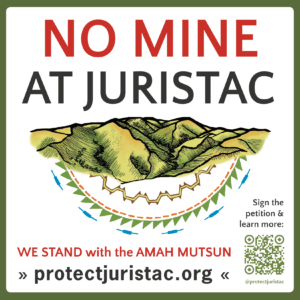
- Organize informational events or comment letter writing parties in your community.
- Identify and reach out to subject matter experts and organizations with pertinent knowledge and experience, notifying them about the Sargent Quarry Project comment period. Ask them to review sections of the EIR relevant to their expertise and submit a comment letter.
- Help recruit additional co-sponsors and attendees for the September 10th Rally for Juristac. Ask organizations you know that have large followings to announce the Rally for Juristac on their social media accounts or in their newsletters.
- Create signs and banners for the Rally for Juristac. See this list of messages approved by the tribe.
- Raise awareness in your community by tabling at major events, or with informational pickets, I.E. by holding banners at overpasses and major intersections and handing out flyers. Contact protectjuristac@gmail.com to request a banner or other campaign materials, and download printable PDFs on our resources page.
- Follow the Protect Juristac Instagram account and Facebook page and share posts
- Help to distribute and place Protect Juristac yard signs, business window signs, flyers and other materials to increase the visibility of the campaign, especially in Santa Clara County
For advice, materials or support regarding any of the above action steps, contact protectjuristac@gmail.com
General tips for writing effective comment letters
- All comments submitted are helpful and welcome. It’s OK to write a simple, short comment letter stating your concerns regarding the mining project. Don’t let a lack of expertise discourage you. As a community member, you have insight and familiarity with local issues that EIR consultants and planners may not. However, if you have time to provide a more in-depth, substantive comment, keep reading for additional suggestions.
- Focus your comments on the sufficiency of the EIR in identifying and analyzing all potential significant impacts to the environment and tribal cultural resources.
- Be as specific as possible in your comments. The more precise your comments are, the more they will compel County staff to consider and respond to them. General statements or opinions will typically result in the stultifying response of “Comment Noted.”
- Begin with browsing through the Summary and Project Description, rather than diving right into the sections most of interest to you and getting mired. Familiarize yourself with how the document is structured, how the alternatives and proposed project are identified, and what the County’s findings of significance are for each environmental category, along with their proposed mitigation measures. Grasping this framework will help you cut through the noise and repetition as you zero in on the sections you want to prioritize reading.
- Read with a critical eye, asking questions as you go such as: Does the analysis make sense? Are assumptions in the analysis flawed? Is the County minimizing the significance of the impacts? Are there significant impacts that the County missed? Can you identify gaps in the logic? Were poor methodologies used? Are the mitigation measures useless, and could better ones be available?
- Separate your concerns into clearly defined paragraphs with headings that reference the specific sections of the documents you are commenting on. Try to keep a narrow focus on each separate issue, rather than mixing topics.
- Address errors, inconsistencies, omissions of data or analyses, outdated information, conclusions not based on evidence, overlooked impacts, or failures to provide discussion required by CEQA.
- Ask pointed questions, in order to elicit a response, IE, “Why was the assessment of wetlands habitat conducted during the summer dry months?”
- Back up your comments by citing facts, evidence (reports, pictures) and expert opinions wherever possible. Referencing personal experience or observations is also helpful. Be sure to keep all referenced evidence organized so you’re prepared to submit it alongside your comment letter.
- It is always better to raise an issue, than to not raise it due to a lack of supportive evidence. Only issues and evidence raised in public comments—even in a cursory way—can be used to support potential future litigation.
- Don’t overlook the alternatives analysis—and specifically, “Alternative 2 – Phases 1 and 2 Only and Processing Plant Relocation.” The applicant (developer) hinted in a recent news article at his intent to pursue this reduced project alternative as a means to gaining project approval.
- Are proposed mitigation measures adequate, feasible, and enforceable? Do they effectively eliminate, minimize or repair significant project impacts? Are “residual impacts” after mitigation understated or minimized?
Mitigation is often distasteful, and many forms of impact cannot truly be mitigated. But keep in mind that if the project were to be approved, an absence of meaningful mitigation measures could be very consequential. Thus, it is appropriate to propose alternative, more robust mitigation measures in your comments and make the case for their feasibility.
- Attach full copies of any documents or reports that you reference within your comment letter, to include them the administrative record. Don’t assume the planning department has access to any document, report or resource that you are referencing.
Key areas of concern in the Sargent Quarry DEIR
This “cheat sheet” provides a brief overview of key topics in the draft Environmental Impact Report (EIR) for the Sargent Ranch Quarry Project, to support your comment letter writing process:
Key Topics and Areas of Concern for Comment Writers (PDF, 6 pages) Updated Oct. 2022
Comment letter template
#1 Basic template: View in Google Docs — Download as .docx, use File > Make a Copy, or just copy-paste the template text and then write and rewrite in your own words.
Additional resources to support comment drafting
- Preparing Comments on the Sargent Ranch Quarry EIR—PowerPoint by Sara Clark
- Video: How to Write Comment Letters on Proposed CEQA Projects—J.P. Rose, Center for Biological Diversity (32 min.)
- Writing an Effective CEQA Comment Letter: Getting Your Points Across (PDF, 3 pages)
- No Need for Sand and Gravel from the Sacred Lands of Juristac aka Sargent Ranch (2 pg. PDF)
- CEQA Glossary of Terms (PDF, 3 pages)
- Overview of CEQA and the EIR Process and how you can participate (PDF / Source: Mt Shasta Ecology Center)
- How to Write an EIR Comment (Source: Californians Advocating Responsible Rail Design)
- How to Comment on a CEQA Document (Source: California Native Plant Society)
- Technical Advisory: AB 52 and Tribal Cultural Resources in CEQA (Source: Governor’s Office of Planning and Research)
- 2022 CEQA Statute & Guidelines Handbook (Source: Association of Environmental Professionals)
Juristac EIR Comment Writing Workshop Video
On Thursday, August 4th the Amah Mutsun Tribal Band hosted a public Zoom-based event on how to write effective EIR comment letters addressing the impacts of the proposed mine at Juristac. We were joined by experts from the Tribe, the Center for Biological Diversity, and the law firm Shute, Mihaly & Weinberger.
A video of part one of this workshop is available here:
Santa Clara County Virtual Planning Commission Hearing

The Santa Clara County Planning Commission held a public hearing to receive spoken comments on the Sargent Quarry DEIR on Thursday, August 25. 84 members of the public, mostly Santa Clara County residents, expressed opposition to the mining project and raised specific concerns with the project and DEIR.
You can watch a full video of the hearing at this link provided by the County.
Frequently Asked Questions

Is it better to submit my comment letter earlier in the comment period?
What matters is that you submit your comment letter prior to the September 26 November 7th deadline. Take the time to ensure that your letter draft is as specific and comprehensive as you would like it to be— as long as you make sure to get it sent off within the comment window.
Am I limited to only one comment letter submission? If I submitted a written comment, do I need to refrain from also providing a spoken comment at the Planning Commission public hearing?
No. You can submit comments in whatever forms you would like, and there is no limitation on providing multiple submissions. Just be certain to submit all your comments before the deadline.
Should I CC my comment letter to the Santa Clara County Board of Supervisors, or to my local city council?
While it is not necessary, you may wish to share your comment letter with relevant elected officials if you feel the points made in your letter are pertinent to readers who are likely not familiar with the technical details of the EIR. To increase the likelihood of elected officials reading your letter, consider attaching your comments in a separate email with a cover message directed to them personally.
What is a "tribal cultural resource"?
California Public Resource Code Section 21074 defines “tribal cultural resources” as sites, features, places, cultural landscapes, sacred places, and objects with cultural value to a California Native American tribe that meet specific defined criteria (see the text of PRC Section 21074)
